Connecting the air conditioner electric motor: diagram and stages of connecting the outdoor and indoor units
A classic household (split) air conditioning system has several electric motors.Plus, manufacturers of this type of equipment provide in advance for the connections of all electric motors included in the structure. Therefore, end users are left with only a small part of working with the electrical circuit.
In this article, we will take a closer look at what and how a potential owner of the equipment needs to do in order to correctly connect the air conditioner electric motor and put the equipment into operation. We will also talk about the features of the split system design, and provide visual photos and useful video materials.
The content of the article:
Scheme of a household split system
Split systems are traditionally used in everyday life for air conditioning. True, in addition to this version of household air conditioners, other designs are also used. However, as practice shows, the operation of other types of climate control equipment is significantly less common.
Air conditioner design features
What is a household split system from a structural point of view?
Actually, this is air conditioning equipment, consisting of two separate modules (blocks):
- Block for internal installation.
- Block for external installation.
Under internal installation This means installing one part of the air conditioner structure (a unit for internal installation) directly inside the room where ambient air treatment is required.
Accordingly, under external installation This means installing another part of the air conditioner structure (a unit for external installation) directly outside the room. As a rule, installation in this case is carried out on the street side of the wall of a house or premises for other purposes.
But first, we recommend that you familiarize yourself with where you can install air conditioning in a private house and apartment.
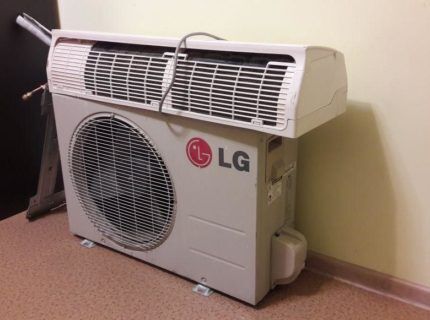
Connection of indoor and outdoor modules
At the next stage, the user needs to connect both modules into a single working system.
It is possible to link modules according to mechanical part pipelines for refrigerant circulation, as well as connection by electrical part electrical cable, respectively. This process is called air conditioner route laying.
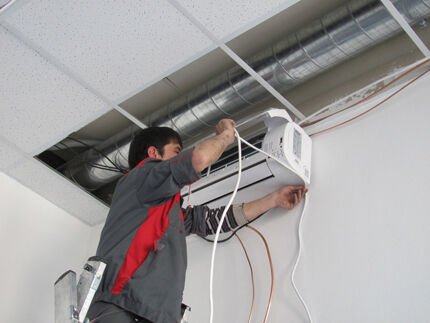
Essentially, a household air conditioner contains several functional electric motors, each of which requires power supply:
- compressor motor;
- outdoor unit fan motor;
- indoor module fan motor.
In addition, the air conditioning system can be additionally equipped with electric motors, the operation of which drives the blinds, directing the outgoing air flow in the desired direction.
Blinds for regulating the outgoing air flow are usually included in the design of the indoor unit of a domestic air conditioning unit.
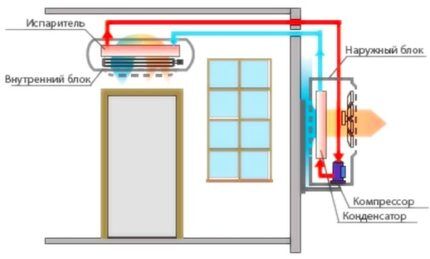
Depending on the power level of the outdoor module of the air conditioning unit, two or more condenser cooling fans (installed in the outdoor module) can be used.
True, such options are rare for household climate control equipment. But for use in offices, split system designs with two fans are quite common.
Instructions for connecting the motor
Now let’s look in detail at how to properly connect the motor of a household air conditioner. Thus, manufacturers of household air conditioners provide the most convenient option for connecting equipment to the power supply network. Moreover, a simplified connection diagram is provided for both single-phase and three-phase networks.
There is no need to directly connect the air fan of the outdoor unit of the air conditioner. It is enough to connect the common (main) power and connection cable to a special terminal. But first, we recommend that you figure out how select and install machine for air conditioning.
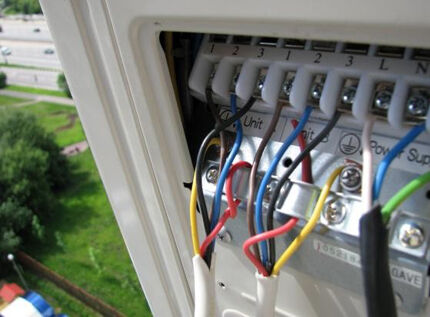
To figure out how to properly connect the electric motor from the air conditioner to the power supply and understand the intricacies of connecting conductors at the switching terminal, consider the electrical diagram of one of the devices.
Electrical wiring diagrams for connecting household air conditioning units have minor differences. Any manufacturer of this type of machine is interested in competition even in terms of convenience (simplicity) of electrical connection.
Stage #1 - connecting the outdoor unit
It’s worth noting an important detail right away: the electrical circuit for switching modules and connecting to the power supply network is always present on the back of the protective terminal cover.
In any case, this practice is followed by well-known manufacturing companies. In addition, the electrical connection diagram is always included in the documentation of the device.
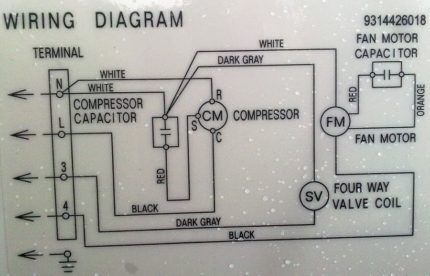
In the connection diagram presented above, you can clearly see the presence of two electric motors present in the outdoor (external) module.
This is, accordingly, compressor motor (CM) and condenser fan motor (FM). Schematically, the power lines of both electric motors are switched and output to the terminal.
Stage #2 - connecting the indoor unit
The split system module, designed for installation indoors, also has a switching terminal through which electrical communication is carried out with the outdoor module. Through the same terminal, power is supplied to the indoor module.

Typically, in the simplest design, a signal pair of conductors is supplied to the terminal of the indoor module, as well as:
- phase;
- null;
- grounding.
Again, depending on the specific brand's air conditioning system design, the electrical connection configuration may look different.
Therefore, you should always carefully read the technical documentation before starting installation work.
Stage #3 - connecting two system modules
So, let’s assume that both modules of the air conditioning system are mounted inside and outside the building - mounted on wall panels:
- a refrigerant pumping line is laid between the modules, consisting of two copper pipes of different sections;
- main pipes are insulated and secured;
- the end points of the main pipes are properly connected to the modules;
- The installed line is tested for leaks with a time delay.
After completing this sequence of operations with a newly installed household air conditioner, you can begin to organize electrical communication between the modules with subsequent connection directly to the power supply. One of the possible options for connecting blocks is shown in the diagram below.
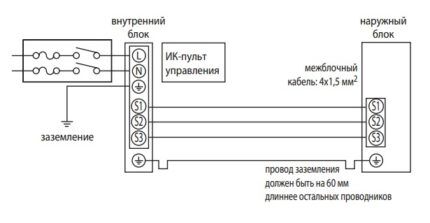
Actually, as can be seen from the above configuration of combining modules with each other, no particular difficulties are expected in the user’s work. You just need to follow the numbering (or designation) of the terminals when making connections between the terminals of the indoor and outdoor units.
That is, if on the external module the electrical wire is connected to the terminal marked “1”, on the internal module the same conductor is also connected to terminal “1”, etc.
Of course, the execution of electrical interconnections, as well as connections to the power supply network, must be done taking into account the correct selection of conductor cross-sections. Allowable cross sections are usually indicated in the documentation for the device in the same section where the electrical circuit diagram is presented.
We also recommend that you familiarize yourself with the selection features places for installing sockets for air conditioner.
Conclusions and useful video on the topic
Thus, connecting the electric motor of the air conditioner (more precisely, the technological connection of a household air conditioning unit) is quite accessible to the user himself. The video clearly demonstrates this procedure:
A home mechanic who decides to connect an air conditioner motor must have the basics of working with refrigerants, plus have an understanding of electrical networks. It is, of course, desirable to have some experience in such matters. If you have absolutely no idea how such a plan works, the best solution is to contact the service.
Do you have personal experience with connecting a household electric motor and want to share it with other users? Or would you like to clarify certain nuances of making electrical connections with our experts? Write your recommendations, ask questions - the feedback block is located below this publication.



